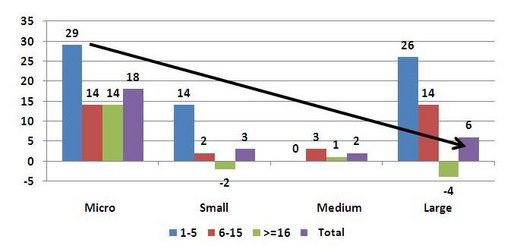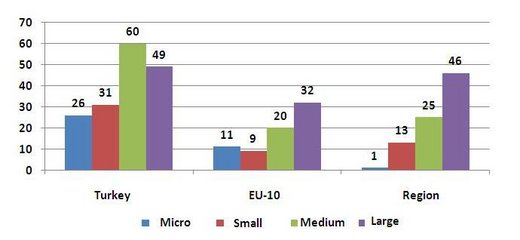TEPAV Articles
- [Archive]
Turkey’s Growth Depends on the Normalization of SMEs 12/11/2010 - Viewed 3265 times
The answer to the question "Why small and medium sized enterprises fail to grow?" might be more complicated than we expect.
Medium Term Plan does not present the story Turkey needs for rapid growth. How this story should be, then? I believe a program that focuses on the growth problems of small and medium term enterprises has to be the backbone of Turkey's growth story. SMEs in Turkey operate exposed to abnormal conditions. It is not likely to ensure rapid growth rates without overcoming the abnormality.
We need to make one observation first: healthy growth of an economy is closely connected either with the growth of firms in that economy or the entry of new firms into the economy. Growth of an economy where individual firms do not demonstrate healthy growth performance is either unsustainable or fails to provide the desired social outcomes such as generating employment. In a dynamic economy on the other hand, newcomer start-up firms, after passing the market test, become small and medium sized and then, in case they sustain the successful performance, grow into large firms. We know that in innovation-led economies, the key to growth is the growth of newcomer small and innovative firms in the market. Firms grow either through productivity gains, employment gains or the combination of the two. The underlying determinants of productivity gains can be the emergence of new products/services, new modus operandi (technological change) or organizational changes.
Growth performance of Turkish firms, however, has an abnormal outlook[1]. The figures below are based on World Bank Investment Climate Assessment Report. A picture is worth a thousand words as the saying goes: the abnormality facing SMEs in Turkey is quite evident. So, instead of overwhelming you with thousands of words, I will simply emphasize some points:
- Figure 1 shows the increase in employment by enterprises between 2004 and 2007 in connection with their age and size[2]. We had better recall at this point that Turkey's economy grew by 6.5 percent in average in the 2004-2007 period. That is to say, we are here scrutinizing the performance of firms over a period where pace of growth more than 50% higher than the historical growth rate (4%) was achieved.
- Micro and large firms grow whereas SME's do not. In broad terms, micro-scale firms in Turkey grow the fastest. This is quite normal. Here is the abnormality: Large firms constitute the group which grows the second fastest. Over the questioned period small and medium sized enterprises barely grew. The outlook for normal economies is quite different than Turkey's: It is normally expected that micro firms grow the fastest, small and medium firms follow them with a rapid if not as impressive pace, and large firms grow with a relatively slower pace. So this is the first abnormality when the SMEs in Turkey are concerned.
- Young firms grow more rapidly than old firms. Figure 1 shows firms' growth performance also on the basis of their age. Newly established micro firms grow two times faster than old micro firms; i.e. firms operating for more than 5 years in the market. Newly established small firms also grew four times more rapidly than their old equivalents. Medium sized firms do not display a considerable difference on the basis of age; indeed medium sized firms in Turkey hardly ever grow. The situation is quite normal also in case of large firms: young large firms grow with a higher pace than old large firms. Thus, there is no significant abnormality in age-related growth performance, except medium sized firms.
- Nevertheless, the rate of old firms in Turkey is substantially higher. Figure 2 reveals strikingly the other abnormality pertaining to SMEs in Turkey. What do you think can be the rate of enterprises older than 16 years among total micro, small, medium and large enterprises in Turkey? To be honest, I was quite surprised learning the answer since scarcity of rooted and long-established enterprises has always been a matter of complaint in Turkey. But compared to the European Union and the Europe and Central Asia region, Turkey's market is dominated by significantly older firms. For instance, across the medium sized enterprises among the 10 largest economy of the European Union, the share of firms older than 16 years is 20 percent; whereas the given ratio for Turkey is as high as 60! The share of old firms in Turkey is relatively higher as well considering other firm sizes. I believe this, along with the above observation, is evidence to the abnormality in the dynamism particularly of medium sized enterprises in Turkey.
- After stating these abnormalities, the question to be asked would naturally be what to do. However, the answer to the question "Why small and medium sized enterprises fail to grow?" might be more complicated than we expect. What needs to be done is to clean, smoothen and improve the 'Innovation and Entrepreneurial Ecosystem; i.e. 'environment' firms operate in, throughout the period from the realization of a business model idea to the phase of rapid growth and establishing a presence in the market. Turkey's achieving rapid growth in the future seems to be tied closely to the repairing of this ecosystem and thus the normalization of SMEs. I will deal with the issues how to repair the ecosystem and where to start address in the next commentary.
Figure 1 Picture of SME Abnormality: Growth rate of firms by age and size (2004-2007)

Source: World Bank, Firm Surveys (2008)
Figure 2 Share of firms older than 16 years, by firm size, 2008

Source: World Bank, Firm Surveys (2008)
[1] To begin with, as the TURKSTAT lags behind in issuing firm level data, there is not much academic research on this issue. This commentary is based on the data announced in the Investment Climate Assessment Report, a report that unfortunately does not attract the attention it deserves, announced in May 2010 by the World Bank. If you are interested in Turkey's economic growth, I strongly recommend you to read this report.
[2] World Bank defines firms employing less than 10 people as micro firms; firms employing 11 to 50 people as small firms and 51 to 250 people as medim firms; and firms employing more than 251 people as large firms.














